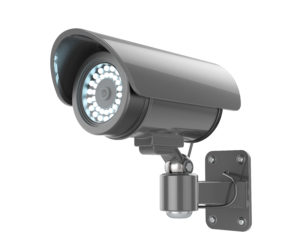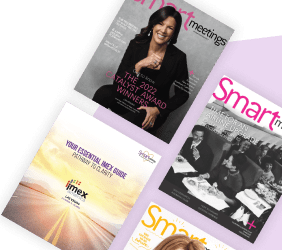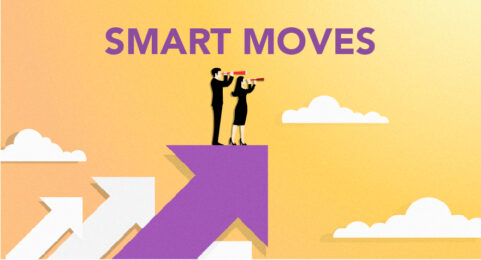Readers tell us how they managed shifts in tech, F&B, sustainability and wellness
Meeting professionals see it all in the ballrooms of the world. Robots, holograms, beans shaped to look and taste like trout—been there, done that. In a survey conducted in October, Smart Meetings asked our trend-spotting readers what new advances—and challenges—they faced in 2019. Then, to help you get ready when these changes come to your next meeting, we asked them how they coped.
The good news: Most of our respondents (67 percent) said that this year brought a big spike in awareness of the economic impact of the industry—thank you, Meetings Mean Business. The industry is finally being recognized as a strategic asset for the success of the company. Or, at least the C-suite now realizes that planners have the fifth-most-stressful job, just behind firefighters and police officers. And the other 33 percent? They know they are doing a good job, and that’s all that matters, they told us.
More: The Trend in the Mirror: Experts Share Tips for 2020
An elevated profile doesn’t mean all is champagne and raises. Budgets continue to be planners’ biggest challenge as they are squeezed on all sides. Many said their programs are climbing in attendance, but not in how much they are given to produce them. Tightening the budgetary vise even further, the current seller’s market is making it more difficult to negotiate with hotels. Also on the stress-inducing list are last-minute speakers, air-travel hassles and the sheer number of conferences with dwindling staff to help.
Tech-ish
Technology made the list of biggest challenges once again. Many are proceeding cautiously. Our survey showed that while no one is requiring cellphones to be checked at the door, most also aren’t going all Steve Jobs on their attendees by rolling out a barrage of virtual reality, artificial reality and chatbots. A majority are adopting event tech that makes sense—using event apps to be greener and more agile (52 percent) and using social media or event apps to begin and continue the conversation with, and between, presenters and attendees.
Polling and digital questions are popular because they help people participate. “Since people have their phones in their hands anyway, we may as well make it interactive,” said one respondent. Meanwhile, apps have become a one-stop shop for maps, speaker info, networking and downloadable presentations.
One great tip for making technology an enhancement rather than a distraction is introducing the features and use of new technology as part of the opening session so attendees can see the benefits and feel confident about using it.
Sustainable Motives
Meeting professionals across the country are flexing their green muscles, from opting for event apps to ditching plastic straws and recycling lanyards. The majority (51 percent) of respondents said they are shifting to earth-friendly practices because “it is important to leave a livable planet to future generations.” However, almost as many (42 percent) said that “venues have made it easier than ever to conserve budget and resources.” One option in response to our question about sustainability was “Millennials made me do it.” Only a few picked that.
But how to save the planet without breaking the bank? Our savvy readers had suggestions for that, too. In addition to limiting the printing of programs and nixing single-use water bottles, respondents suggested using local products, reusing signage from year to year and picking vendor-partners who share the same goal of a reduced carbon footprint. One planner suggested making sustainability fun with competitive tree planting and nature clean-up projects.
Readers stressed the importance of being transparent with attendees and explaining why changes were being implemented. Communicating the impact small changes can make at conferences can empower guests to be part of the solution.
 Caring Cuisine
Caring Cuisine
If there is one uber-trend in F&B, it is healthy eating. A supermajority (80 percent) of respondents said they are offering healthier options, and a handful of pioneers (17 percent) say they are serving plant-based meat. Fewer offer milk alternatives at coffee and breakfast stations, although almond milk made the cut at Financial and Insurance Conference Professionals annual meeting in Austin.
Sustainability in catering continues to trend. “Waste not” seems to be the mantra of 2019 culinary teams. But how to accomplish this? Many are simply ordering less, often based on data from past events. Since plated meals make portions and food waste easier to control, they are now frequently favored over buffet-style. Others are partnering with the venues—and writing sustainability goals into the contract—to manage waste through real-time ordering of locally sourced ingredients and flash-freezing unserved food for donation to charities. Composting has become the end-all KPI.
One event professional had a very specific solution for reducing leftovers: “omitting honeydew on fruit platters because, really, nobody eats it.”
Well, Well, Well
More meeting professionals than ever (40 percent) are giving attendees options for incorporating wellness into their agendas, with walking breaks, robust hotel gyms, healthy menu choices (there’s that trend again), meditation and spa appointments singled out as popular options—even if many admit they don’t personally have time to use any of these when on the road.
New in the wellness toolbox for planners: step-counting challenges. Attendees sign up to track their trekking during the conference—for bragging rights and, often, a charity donation in the name of the winner.
 What is Secure Enough Today?
What is Secure Enough Today?
Whether it’s a high-profile event or small meeting, attendee safety is one of a meeting professional’s highest priorities. Keeping everyone safe at an event has always been a challenge, but it’s become much more difficult as the world grows more unpredictable.
Today, there are more safety concerns than ever, especially when it comes to data privacy and live shooter attacks, but natural disasters and health emergencies rear their ugly heads, as well. Smart Meetings asked readers how they are managing security and how they are ensuring that attendees feel safe.
Relatively Important
More than half of respondents (52 percent) agreed with this statement: “Having a security plan is important, but not more important than amenities and price.” One out of four (27 percent) said they had detailed security/emergency plans and used metal detectors, or have pulled a meeting from a venue if its security protocols didn’t measure up. Only 21 percent said they are “just not that worried about it.” Many said they rely on hotel partners to do the heavy lifting when it comes to creating these plans, and then review them during Pre-Con meetings.
Messaging Matters
Meeting professionals also must ensure that attendees feel safe. Respondents pointed to the presence of security guards and dogs at the doors, baggage checks, the choice of venues with a reputation for being safe and messaging about security measures in emails. “If guests know what is available to them and understand our plans if there is a crisis, they have greater confidence and comfort during the conference,” said one respondent.
In the end, only so many measures and precautions can be taken, and there is shared responsibility among all parties, including attendees. But planners still must be ready to take care of their attendees in case of an attack or emergency.
–Sofia Wright
To Fee or Not to Fee?
The year 2019 was the one that the proliferation of resort/urban/other fees being charged by hotels caught the eyes of attorneys general in two states, and lawsuits were filed against Marriott International and Hilton over how the charges—which are collected whether or not a guest uses the upscale gym, pool and services—were communicated to prospective guests. Sean Hennessey, clinical assistant professor with Tisch Center of Hospitality, said the problem with the fees is largely a lack of clarity in advertising and may lead to increased disclosure to avoid the charge of deceptive practices. The outcome of those court cases may impact some groups more than others.
The majority of meeting professional respondents (53 percent) to the Smart Meetings survey said they already negotiate for just the things their group will use in the room block rates. One respondent said, “If they want my business, they waive these fees.”
However, a third (30 percent) said there may need to be better disclosure. “Inclusive packages make everyone happy—it’s easy for planners to see their totals and the hotels get their costs covered,” explained one planner.
Another 16 percent said they should be banned. Many complained that the practice, which mirrors how airlines are charging extra for things that used to be included, such as seat assignments and luggage, has gotten out of hand. “It is really quite rude,” said one, complaining that what started as a moderate fee is now $55 or more at some properties.
David Bruce, executive director of Alliance of Independent Meeting Professionals, pointed out that the fees and emergence of things such as equipment rental come outside the room block rate and are therefore not able to be commissioned. “It doesn’t make much sense,” he said. “We are already charged a premium to stay in the nice resort, then charged a fee because we are in a nice resort. That concerns me.”




